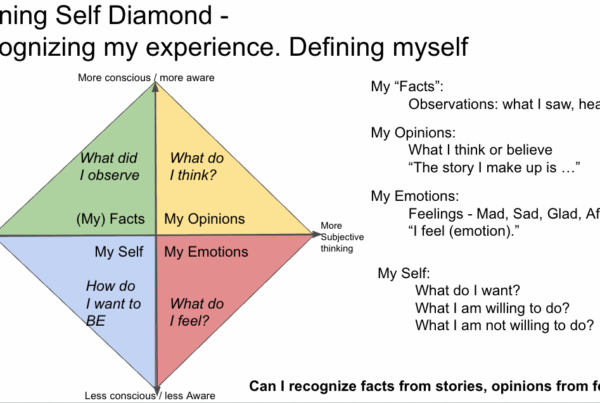
When is comes to making changes in relationships, why does it take time to make a significant change and what can one do about this?
News flash. I’m not perfect. My immaturities and anxiety lead to me being more reactive in relationships than I want. My reactivity can lead to me being a victim, blaming others, making up stories, and not functioning as a responsible family member. I know I’m not alone in this. We all come by our “stuff” or “baggage” honestly. I don’t believe anyone wakes up with the clear thought of “hey, how can I be a really irresponsible person today?”
Changing a pattern is hard and takes time
Our behaviour is a function of the environment, our physiology, and nervous system. These last two items were established early in the womb. The development continues after birth and depends a lot on our family, but also environmental circumstances. For example, a more chaotic household has a bigger effect than socio-economic status on a child development, but both have an impact. A lot of this development is at the autonomic nervous system level – outside of our awareness. How old were you when you learned about “hot” and what not to touch? Now that awareness is completely automatic. Any habit, a pattern of behaviour, is also automatic and outside of conscious control. Only with effort can we consciously work at controlling such behaviour.
Four basic patterns
We learned how to be in relationships at an early age. Thus, in relationships, we react to perceived threats with one of the four basic emotional patterns that Dr. Bowen wrote about. The four emotional patterns are conflict, distance, over and under functioning, and projection or triangling. The specific behaviours (aka “content”) that reflect these patterns can vary. How one displays “conflict” for example, can vary a lot, but it’s the emotional process of resisting change / trying to change the other that is the underlying emotional process.
Anxiety – the one that rules them all
Anxiety and the effect of stressors on oneself can increase how reactive one is and what is perceived as a threat. One can end up perceiving a threat where one doesn’t exist. Or one may think it’s much worse than it is. Anxiety is common across these emotional patterns because that is what “energizes” them. It increases their intensity.
The patterns result from a person trying to lower their sense of tension, discomfort, or anxiety. For example, this can show up as trying to avoid a discussion or “rocking the boat”. Let’s use distance to illustrate this. A partner gets absorbed with work to avoid being at home (physical distance) because of some unresolved issue and the tension it has created. Or they go home but use substances to create “psychological” distance. The distance reduces the discomfort and perceived threat in the short term, but it doesn’t resolve the issue. Anxiety fueled immaturity wins over responsible functioning. In addition, the pattern gets reinforced.
Relationship changes are habit changes
We develop patterns of emotional functioning in our family of origin. These can pop up in any significant relationship. Like habits, they are automatic and nonconscious. Most people don’t consciously decide “now would be a good time to have some conflict”. Or if they do, it’s a reactive process, not a truly thoughtful one. While habits help the brain be efficient, that efficiency makes it hard to change them.
It is also important to remember that all this is taking place in the family, or work, emotional system. The patterns are an individual’s reacting to the emotional system. The patterns were developed as a way to adapt to the emotional system in one’s family of origin. However, an individual can’t change a system. They can only work on the part they play in the system. More importantly, the change has to be for self. The change won’t work if used as an indirect way of trying to change the system.
How to Change: the O R D E R method
So how does one change their patterns? Since the effort involves changing the nervous system, synaptic connections, and receptors, this it going to take time. However, my experience is that one can speed things up with the right approach. The approach I’ll offer is informed by Bowen Theory. I call it the ORDER method.
1. Observe – you only change what you notice
The process starts with being a good, at the moment, observer. This skill takes time to develop. Have you ever learned a new language? Do you remember how your ability to recognize distinct works in a stream of speech grew better? Your ability to notice when a pattern is happening or going to happen can also increase over time. The key is your desire, your intention to notice. This can take a month or more to get pretty good at it. It mostly depends on the importance to you and the number of times something happens. For example, if you don’t want to burn yourself when lighting a candle, you will get very good at this quickly.
2. Reflect – you can only change what you own
Once you can observe when and under what situations a pattern is happening, you can reflect on the part you are playing. Let’s use the candle example again. You are trying to light four candles and you burn your fingers. This has happened four times in the last ten days. What you have noticed is that it happens when the match is pointing down, which allows the flame to burn up the match faster. So you realize the part you are playing. It’s not the match’s fault!. You decide to own the part you are playing and think about how to hold the match differently.
Observing and reflecting can take weeks to get good at. When I first started, it could be hours after an event that I could see what I had done. Then I could reflect on it and think about how I might be next time.
3. Decide – you only change what you want to
A vital part of the observation is to see the part one is playing. It’s all about self and how one is acting and reacting. As one sees how they are acting / reacting, then they can decide what part to change. An individual has to get clear on HOW they want to change. What behaviour will replace the default behaviour? It’s very important to have a conviction about this. Without conviction to be different, one won’t change. You “umph” to change has to be greater than the emotion force to be reactive. Literally, the stronger neural circuit wins.
Back to the candles. I have several choices. I can just not light candles any more (distance). Or I can buy matches that are longer (that’s like blaming the match). Or I can hold the match level or pointing up slightly. I decide to do this last approach. It works almost all the time. So this is how I’m going to act all the time. I also realize that this is the most adaptive behaviour as it helps in a variety of situations with different matches.
4. Execute – you only change with action
So you noticed how you react. You’ve identified your part in an interaction. You’ve gotten clear about how you want to be different. And you have conviction about this, because you understand the value – to you – in changing. All this is for nothing if you don’t follow through and act on your observation and conviction. One has to execute. This can create its own anxiety, so it’s good to lean in and do one’s best.
Here’s a relationship example. Let’s say you stomp out of the room when things get heated. You’ve noticed this is your pattern. While it works in the moment, it resolves nothing. You’ve decided that you need to stay engaged with the person and not leave the room. Furthermore, you realize that it’s when the other person raises their voice that you get anxious and want to leave. So you decide to focus on your breathing and just let them talk. When they stop talking, you are going to say, as calmly as possible, “I’m feeling quite anxious, but I want to work this out. I just need a few moments to calm myself. Is that okay?”
It’s hard to provide a truly good example in one paragraph, but hopefully, you get the idea. I’m sure you can come up with something for your situation that works for you. For example, you might even leave the room, count to ten and then come back. Each person has to decide what works for them in their particular situation.
5. Repeat – you only create a new patter with repetition.
Repetition is so important. We rarely get it right the first number of times. We don’t stay as calm as we’d like. Somehow, we just can’t say what we would really like. But with practice and repetition, the anxiety comes down and we can do better. I believe that a very clear visualization of a situation can help. It lets one practice safely, especially if the visualization is detailed enough. Besides, it’s unlikely that others will want to create the situation five times a day so you can practice! With repetition, the new pattern takes hold. The old pattern is losing its grip. But remember, the intensity of your conviction and the number of times you “practice” will determine how quickly the new behaviour becomes more automatic.
Making changes in relationships takes time
I should have said – it takes weeks to months. Why? It literally takes many “trials” over a period of weeks to months to create a new habit. That’s because you are rewiring your brain. Literally, you are making new neural pathways stronger and more likely to fire given certain situations. This is why conviction is so important. The brain needs to know our intention for any situation, so it knows what to tell us to do. Your conviction to be a certain way informs the brain – it gives it an “order” to get you to act in the way you want.
Yes, I believe you need to think of this ORDER process as an “order” to the brain.
Here’s the good news. Movement towards a new pattern is better than reinforcing the old pattern. Any deposit into the relationship account grows the value of the account. A deposit is better than a withdrawal. Even being less reactive, making a smaller withdrawal is an improvement.
The only way this approach won’t work is if one just doesn’t work it.
I know from experience that this is easier “said than done”. But it can be done. Good luck with your patterns!
Thank you for your interest in family systems.
Dave Galloway
dave.galloway@livingsystems.ca
Would you like to read a post on a particular topic?
Send me your ideas – dave.galloway@livingsystems.ca
Check out our podcast on Youtube
Read more about Bowen Theory here
This post might also be of interest: Perceptions Matter


